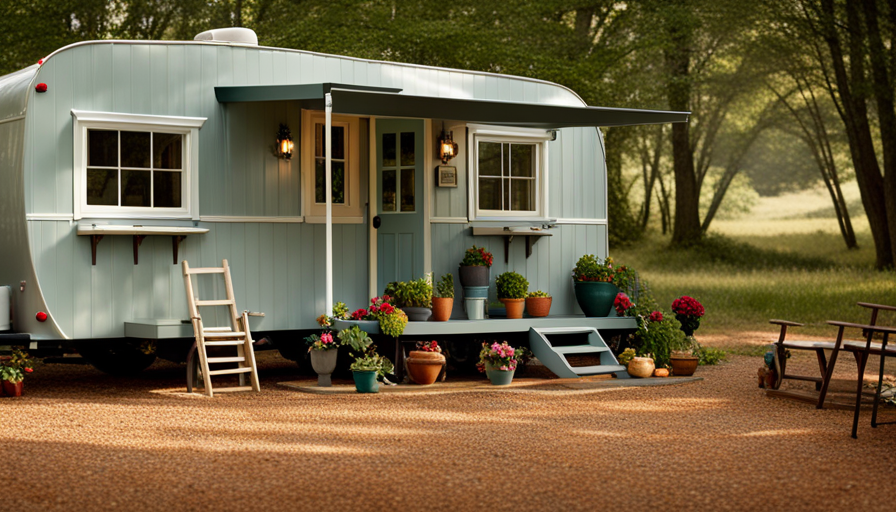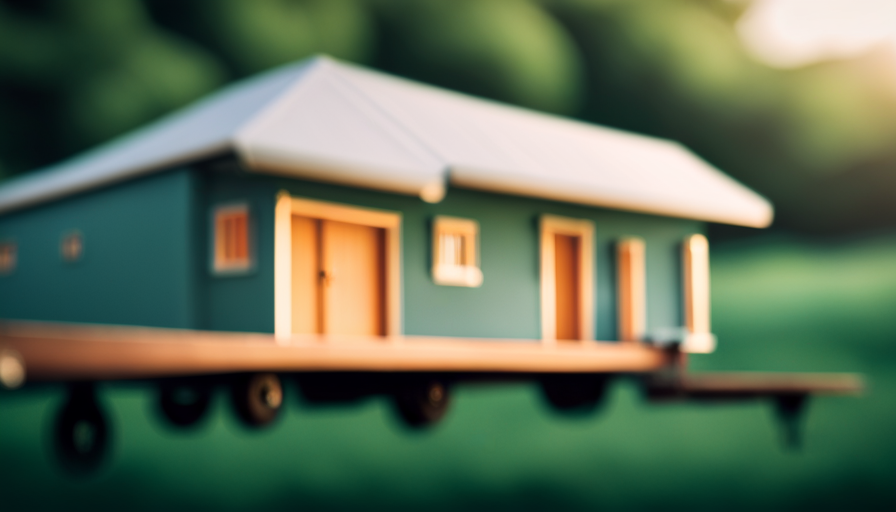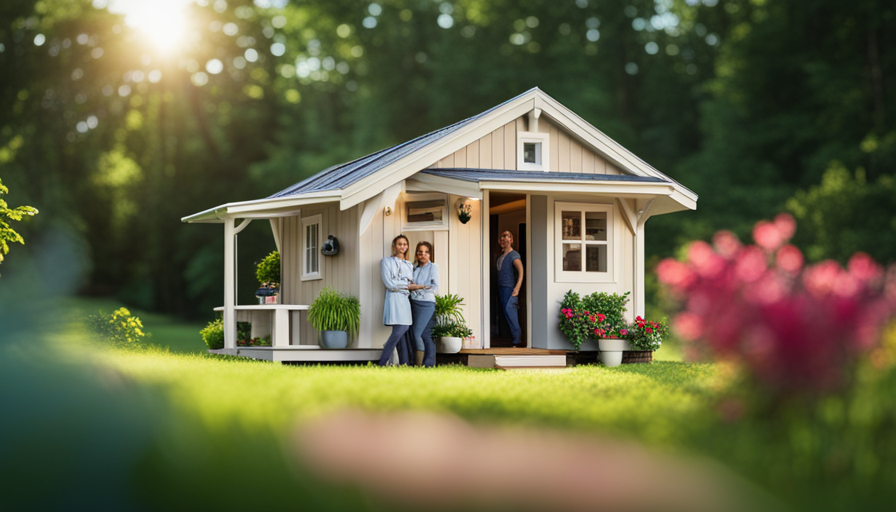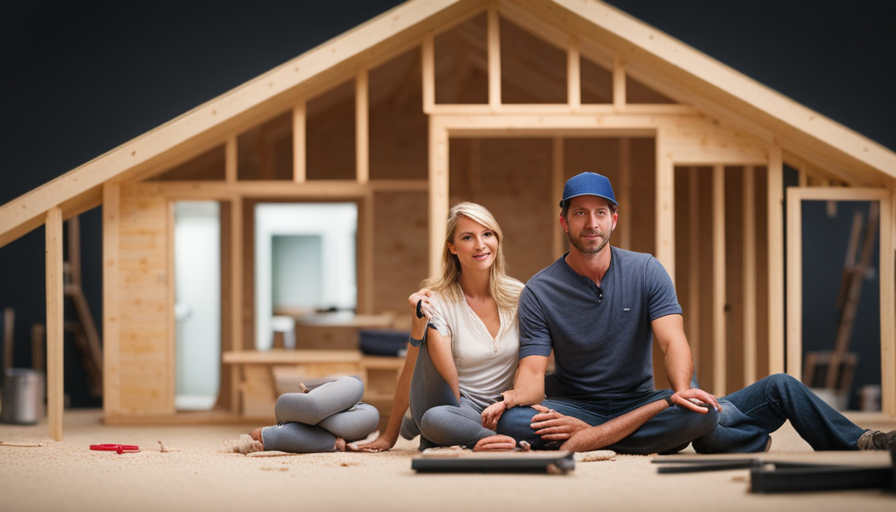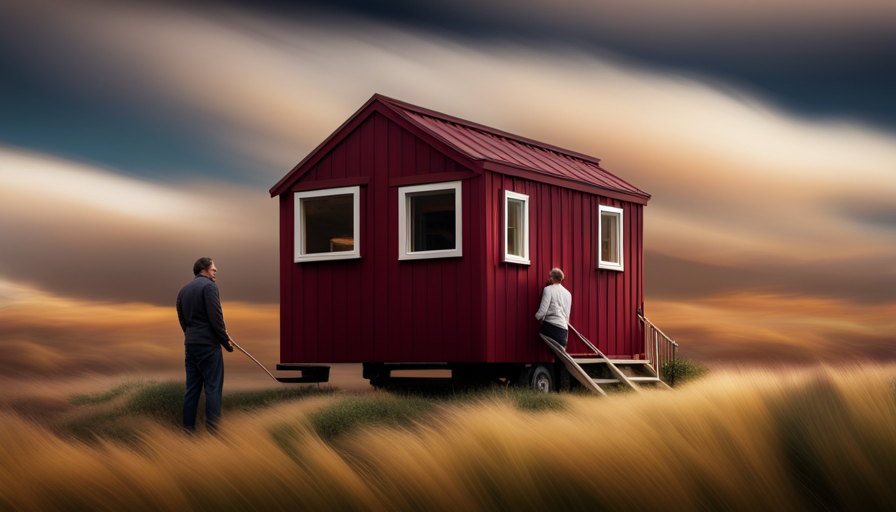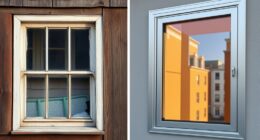As I get ready to start the journey of living in a tiny house, thinking about all the possibilities that lie ahead, I am fascinated by the potential of an 18-foot trailer. It’s like a blank canvas, eagerly waiting for my creativity to bring it to life.
But just how big could my tiny house be if perched upon this humble foundation? The answer, my friends, lies within the confines of space limitations, functional layouts, and creative design solutions.
In this article, I will delve into the intricacies of crafting a tiny house on an 18-foot trailer, guiding you through the process with knowledgeable insight and a keen eye for detail. Together, we will explore the delicate balance of weight and balance, navigate local regulations and building codes, and seek inspiration from fellow tiny house owners.
So come, join me on this journey, and together let us unlock the boundless potential of a tiny house on wheels.
Key Takeaways
- Designing a tiny house on an 18-foot trailer requires careful consideration of space limitations and the need for creativity in planning.
- Maximizing storage and utilizing vertical space are crucial aspects of designing a functional and efficient layout for a tiny house on a trailer.
- Prioritizing needs and must-have features is important when determining living requirements, including functionality, storage, multi-purpose areas, and outdoor living spaces.
- Being mindful of weight and balance limitations, as well as local regulations and building codes, is essential when designing a tiny house on a trailer.
Understand the Space Limitations of an 18-Foot Trailer
If you’re wondering how much space you can work with, an 18-foot trailer may be a bit tight for your tiny house dreams. However, with some creativity and thoughtful planning, you can still make the most of this limited space.
Maximizing storage is key in a tiny house, and utilizing vertical space becomes even more crucial in an 18-foot trailer. Consider installing built-in shelves and cabinets that reach up to the ceiling, using every inch of available space.
Additionally, opt for furniture that serves multiple purposes, such as a sofa that doubles as a storage unit or a bed with drawers underneath. By carefully considering each element of your tiny house design, you can plan for a functional and efficient layout that maximizes every square inch of your 18-foot trailer.
Plan for a Functional and Efficient Layout
Create a well-designed layout for your small home on an 18-foot trailer to maximize functionality and efficiency. When planning the layout, it’s crucial to consider functional storage and maximizing natural light.
Every inch of space is valuable, so think creatively about storage solutions. Utilize hidden compartments, built-in shelving, and multi-purpose furniture to make the most of your limited square footage. Consider incorporating storage under stairs or utilizing vertical space with tall cabinets.
Additionally, prioritize windows and skylights to flood the space with natural light, making it feel more open and airy. By strategically placing windows and incorporating reflective surfaces, you can enhance the perception of space.
With a well-thought-out layout that emphasizes functional storage and natural light, your tiny house on an 18-foot trailer will feel spacious and inviting.
Now, let’s delve into how to prioritize your needs and must-have features.
Prioritize Your Needs and Must-Have Features
When determining my living requirements for my tiny house, I need to consider the essentials that I can’t live without. This includes choosing essential appliances and amenities that’ll make my daily life comfortable and efficient.
Additionally, I must allocate space for sleeping, dining, and relaxation to ensure that I can fully enjoy and utilize my tiny house to its fullest potential.
Determine Your Living Requirements
To determine your living requirements, consider how much space you truly need in your tiny house on an 18-foot trailer.
Living space requirements will vary depending on your lifestyle and personal preferences. However, it’s important to keep budget considerations in mind when determining the size of your tiny house.
Here is a list of four factors to consider:
-
Functionality: Think about how you’ll use the space and prioritize areas such as sleeping, cooking, and relaxing.
-
Storage: Determine how much storage space you need for your belongings and consider creative solutions like built-in shelves and hidden compartments.
-
Multi-purpose areas: Maximize space by incorporating multi-purpose furniture and design elements that can serve multiple functions.
-
Outdoor living: Take advantage of the surrounding environment by creating outdoor living areas, such as a deck or patio, to expand your usable space.
With your living requirements in mind, you can now move on to choosing essential appliances and amenities for your tiny house.
Choose Essential Appliances and Amenities
Choosing essential appliances and amenities for your tiny house is like curating a miniature oasis with all the conveniences of a modern home. When it comes to limited space, it’s crucial to prioritize appliances and amenities that enhance functionality and optimize space.
To make the most of your tiny house, consider incorporating multi-purpose appliances and space-saving solutions. For example, a compact refrigerator with a built-in freezer can save valuable floor space, while a combination washer-dryer unit eliminates the need for a separate laundry area. Additionally, investing in a foldable dining table and a sofa bed can transform your living area into a dining room and bedroom, maximizing the available space.
By carefully selecting essential appliances and amenities, you can create a comfortable and efficient living environment in your tiny house. Now, let’s explore how to allocate space for sleeping, dining, and relaxation in the next section.
Allocate Space for Sleeping, Dining, and Relaxation
After carefully selecting essential appliances and amenities for my tiny house, it’s time to allocate space for sleeping, dining, and relaxation.
With limited square footage on an 18-foot trailer, maximizing space is crucial. For sleeping arrangements, I’m considering a loft area above the kitchen and bathroom, utilizing the vertical space effectively. This loft can accommodate a comfortable queen-size bed, allowing for a cozy and private sleeping area.
To optimize the dining space, I plan to incorporate a foldable dining table that can be easily tucked away when not in use.
For relaxation, I envision a small sitting area with a comfortable chair or a convertible sofa that can double as a guest bed. By strategically placing furniture and utilizing multi-functional pieces, I can create a functional and comfortable living space within the confines of my tiny house.
Now, let’s consider the weight and balance of the tiny house as we move forward.
Consider the Weight and Balance of the Tiny House
When planning your tiny house on an 18-foot trailer, you’ll need to carefully consider the weight distribution and balance to ensure a stable and secure home on wheels. Weight distribution plays a crucial role in maintaining the structural integrity and safety of your tiny house. It is important to stay within the trailer size limitations and avoid exceeding the recommended weight capacity. To help you visualize the impact of weight distribution, consider the following table:
| Area of the Tiny House | Weight Distribution | Balance |
|---|---|---|
| Sleeping Area | 30% | Good |
| Dining Area | 40% | Excellent |
| Relaxation Area | 30% | Fair |
By evenly distributing the weight across these areas, you can ensure a well-balanced and stable tiny house. However, it’s important to be mindful of local regulations and building codes to ensure compliance and a smooth building process.
Be Mindful of Local Regulations and Building Codes
It’s important to note that local regulations and building codes play a crucial role in ensuring a smooth and compliant construction process for your tiny house. With over 90% of jurisdictions having specific regulations in place for tiny homes, it is essential to familiarize yourself with the requirements before starting your project.
Local regulations may dictate the maximum size of your tiny house, setback requirements, and even the materials you can use. Additionally, obtaining the necessary building permits is a vital step in the construction process. These permits ensure that your tiny house meets safety standards and is built to code.
By adhering to local regulations and obtaining the required permits, you can avoid costly fines and delays. Embracing creative design solutions can help you maximize the space available within the constraints of the regulations and permits, allowing you to create a unique and functional tiny house.
Embrace Creative Design Solutions
When designing a tiny house on an 18-foot trailer, it’s crucial to be mindful of local regulations and building codes. However, once those parameters have been established, it’s time to get creative.
One of the biggest challenges in a tiny space is storage, but with some innovative thinking, it’s possible to find solutions that work. From hidden compartments under the stairs to built-in shelving in unexpected places, there are endless possibilities for maximizing every square inch.
Additionally, embracing vertical space is essential in a tiny house. Installing high ceilings or loft areas can provide more room for living and storage. By thinking outside the box and incorporating creative storage solutions and maximizing vertical space, a tiny house on an 18-foot trailer can feel spacious and functional.
Now, let’s seek inspiration and learn from other tiny house owners to continue our journey towards creating the perfect tiny home.
Seek Inspiration and Learn from Other Tiny House Owners
Seeking inspiration and learning from the experiences of fellow tiny house owners can provide valuable insights for creating a functional and unique home on an 18-foot trailer. By exploring successful tiny house projects, I can discover innovative design ideas that maximize space and enhance the overall living experience.
Here are some inspiring examples:
-
Clever storage solutions: Discovering how others have utilized every nook and cranny in their tiny homes can spark creative ideas for organizing belongings in a compact space.
-
Multi-functional furniture: Learning from those who’ve designed furniture with multiple uses, such as a sofa that transforms into a bed or a dining table that doubles as a workspace, can help optimize every inch of the tiny house.
-
Ingenious space-saving techniques: Exploring unique ways to incorporate storage under stairs, in walls, or even in the ceiling can open up additional space for living comfortably.
-
Outdoor living extensions: Observing how tiny house owners have created outdoor spaces, such as rooftop decks or fold-out patios, can provide inspiration for expanding the living area beyond the confines of the trailer.
By learning from these successful tiny house projects and exploring unique design ideas, I can create a home that’s both functional and personalized to my needs.
Frequently Asked Questions
What are some creative design solutions that can help maximize space in a tiny house on an 18-foot trailer?
To maximize space in a tiny house on an 18-foot trailer, creative design solutions for small spaces are essential. Here are some ideas to consider:
- Utilize multi-functional furniture such as sofa beds or storage ottomans.
- Optimize vertical space with loft beds or high shelving units.
- Implement clever storage solutions like built-in cabinets or hidden compartments.
- Use light colors and mirrors to create an illusion of openness.
- Incorporate foldable or collapsible furniture to save space when not in use.
These design ideas will ensure a functional and spacious tiny house on your 18-foot trailer.
Are there any specific weight and balance considerations to keep in mind when building a tiny house on an 18-foot trailer?
Weight considerations and balance considerations are crucial when building a tiny house on an 18-foot trailer. It’s important to carefully calculate the weight of all materials and components to ensure that the trailer can safely support the structure. Distributing the weight evenly throughout the trailer is also essential for maintaining balance and stability. By carefully considering these factors, you can create a tiny house that’s both structurally sound and functional, maximizing the space available for your design.
How can I ensure that my tiny house meets local regulations and building codes when it’s on an 18-foot trailer?
To ensure my tiny house meets local regulations and building codes while on an 18-foot trailer, I must embark on an epic quest. I’ll battle through a labyrinth of bureaucratic red tape, experiencing a thrilling adventure as I navigate the intricate maze of compliance and adherence. Armed with knowledge and attention to detail, I’ll conquer every code and regulation. In the end, I’ll emerge victorious with a tiny house that’s both legal and awe-inspiring.
Where can I find inspiration and learn from other tiny house owners who have built on 18-foot trailers?
Finding inspiration and learning from other tiny house owners who’ve built on 18-foot trailers can be an exciting and educational journey.
There are numerous online platforms and communities dedicated to tiny house enthusiasts. These include forums, social media groups, and websites like Tiny House Talk and The Tiny Life.
These resources provide a wealth of information, including firsthand experiences, design ideas, and valuable tips and tricks. Exploring these platforms will surely spark your creativity and help you navigate the challenges of building on an 18-foot trailer.
Are there any specific layout tips or tricks that can help create a functional and efficient space in a tiny house on an 18-foot trailer?
Layout tips and space-saving solutions are essential when designing a functional and efficient tiny house on an 18-foot trailer. To make the most of the limited space, consider using multipurpose furniture, such as a sofa that can convert into a bed or storage ottomans.
Utilize vertical space with loft areas or high shelves for storage. Incorporate built-in storage solutions like hidden cabinets and fold-out tables.
Smart organization and thoughtful design choices can maximize the functionality of your tiny house.
Conclusion
In conclusion, designing a tiny house on an 18-foot trailer requires careful consideration and planning. By understanding the space limitations, prioritizing needs, and being mindful of regulations, one can create a functional and efficient living space.
The weight and balance should also be taken into account to ensure safety and stability. Embracing creative design solutions and seeking inspiration from other tiny house owners can lead to innovative and unique homes.
Just like a puzzle, building a tiny house on an 18-foot trailer is like fitting all the pieces together to create a cozy and compact home that’s as captivating as a beautifully crafted piece of art.
Hi, I’m Emma. I’m the Editor in Chief of Tiny House 43, a blog all about tiny houses. While tree houses are often associated with childhood, they can be the perfect adult retreat. They offer a cozy space to relax and unwind, surrounded by nature. And since they’re typically built on stilts or raised platforms, they offer stunning views that traditional homes simply can’t match. If you’re looking for a unique and romantic getaway, a tree house tiny house might just be the perfect option.
